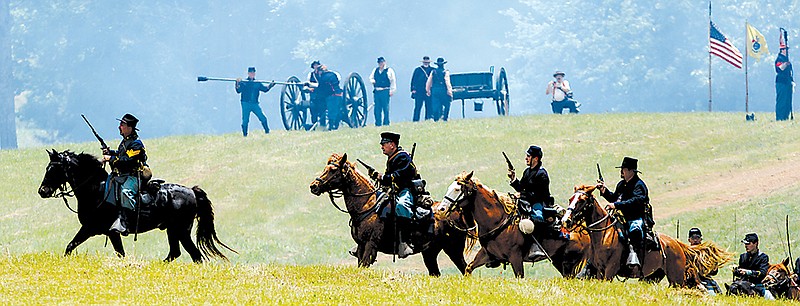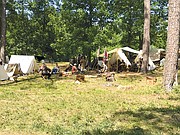As someone who loves history, I've always been curious about Civil War re-enactments. Apparently I'm not the only one. In a recent poll conducted by the Chattanooga Times Free Press, about 40 percent of respondents said they had attended one of these demonstrations.
I decided it was about time for me to see what all the fuss was about - and there's certainly quite a bit of fuss involved. The "living historians" I saw depict the Battle of Resaca attended to even the smallest of details in order to create the most authentic experience possible.
Held annually the third weekend in May, the re-enactment depicts the two-day struggle in which about 5,500 people lost their lives as General William T. Sherman marched toward Atlanta. My husband and I arrived just as the battle began.
As we approached the battle lines I saw the first of many men display a lean so perfect, I was sure he must have had at least a few decades of experience seeking shade under this particular tree, slowly sipping from his canteen in period garb. Like many of the re-enactors I saw that day, he seemed to be perpetually posing for a portrait. I imagine this must be because, in studying for his role, he likely looked at photos from the period in which the subjects actually were posing for long periods of time, resulting in similarly artful leaning poses.
The shots had already begun, and people scurried about the medical tent near the front line. I jumped at the first shot of the cannons and every shot thereafter. It reminded me of watching fireworks when I was little, when every pyrotechnic burst made me want to put my hands over my ears but didn't seem to phase the other onlookers around me.
My favorite parts to watch were when the two sides approached each other on horseback, clanking swords and doing their best not to smile (or actually hurt someone, though I'm pretty sure their hearing was the only thing that would suffer from the day's events).
The spectators, about a quarter of whom were also dressed in period attire, were gathered on a grassy knoll. Most had brought their own camp chairs, and those closest to the action and in the few remotely shaded areas had clearly staked their spots out early. There were many smart folks who'd thought to bring umbrellas to shield themselves from the blazing mid-afternoon sun, though the "period" variety made of black lace seemed to have little effect. The children in period attire were the most adorable, but I couldn't help but think they were probably wishing for a period version of the over-ear headphones many of their modern-day counterparts were sporting to block the deafening shots ringing across the battlefield.
While the novelty of seeing a "real," live-action battle kept me entertained for its hourlong duration, it did feel a little unsettling to view such a tragic event as entertainment. And I couldn't help but feel sorry for the re-enactors, many of whom were getting up there in age, in their woolen attire, especially those who were playing dead for much of the hour without shade or water.
The most interesting part of the experience for me was the culture surrounding the re-enactment. Following the battle, the re-enactors returned to the camps they'd set up prior to the 9 a.m. deadline for all vehicles to be cleared out until time for the camps to come down on Sunday. Re-enactors eschew the conveniences of modern life, limiting themselves to what was available to soldiers back in 1864: cooking on cast iron over open fires, smoking tobacco from pipes and perusing the wares on Sutler's Row. Sutlers were civilian merchants who accompanied troops into the field to sell supplies, food and drink.
The living historians' version of Sutler's Row is limited to vendors selling only period items, meaning items that look like they're from the period or produced as they would have been during the period, as opposed to actual period relics. Think handmade clothing, wooden toys, dolls, mess kits, knives, rifles and leather goods. Even the food vendors do their cooking over a fire, as there is no electrical access.
The row of tents was packed with shoppers. As I watched leathersmith Fred Healy sew a holster in his tent on Sutler's Row, he told me he's been in the business for more than 40 years, under the name Le Pierre Sutler. He specializes in 18th and 19th century leather goods, and says he's one of the only artisans in the Civil War re-enactment circuit who still practices his craft "in the field" and that he was the only one doing so in Resaca that weekend. When he first started, he says, there were many artisans practicing their crafts on-site, as they would have done historically.
Still, the only indication we were in 2017 were the iPads Sutler's Row vendors used to run credit cards as people purchased herbal soap, hat pins, playing cards without numbers (the numbers and letters, or corner indices, weren't common on American card decks until about 1875) and other camp essentials. Entertainment was limited to period dances, tic-tac-toe and jaw harp-playing.
So just a few feet from Sutler's Row, I was surprised to find a line of 21st century food trucks hocking everything fried, which could be enjoyed in a large, shady tent. As I sat down for a burger and mused on this unexpected - but admittedly welcome - departure from the day's theme, a Confederate soldier in a wool uniform slid into one of the nearby plastic chairs for a moment of relief before making his way back to camp. He's from St. Augustine, Florida, where he has a job leading historical tours when he's not traveling to re-enactments across the country. He takes a hiatus from living history between late spring and fall, as the summer heat in the South can be too much to bear. He wasn't excited about the rain expected during the following day's battle, but was comforted by the fact that he'd have an air-conditioned room that night - an outside-the-period luxury he's not ashamed of taking advantage of when he's on the road.
The Battle of Chickamauga will bring him back to the area in September. Though he probably won't see me there, I am glad the living historians were willing to let me into their alternate universe for an afternoon.

